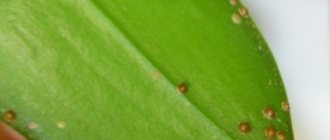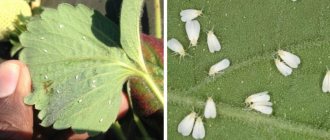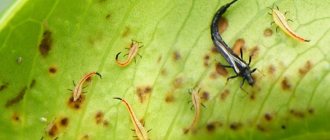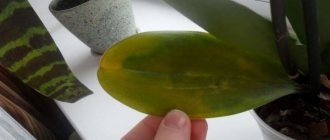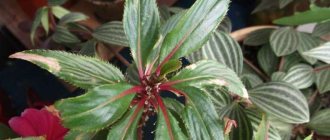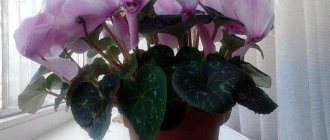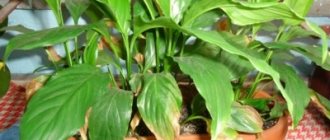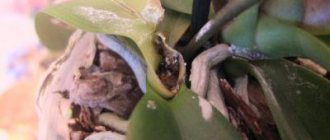Signs of excess moisture
When a plant suffers from excess moisture, its leaves and flowers begin to fade.
The signs of overwatering are almost identical to the signs of insufficient watering, so it is very easy to confuse the problem and try to save the flower by watering it abundantly, which will only worsen the situation. Signs that the plant has begun to deteriorate due to excess moisture:
- yellowness of the green mass (you will learn about other reasons for yellowing of leaves and methods of saving the plant here);
- leaves may suddenly or gradually fall off;
- mold has appeared on the surface of the soil, the soil itself is damp and sour;
- softening the stem;
- lack of leaf elasticity;
- the shoots turn black.
What happens when a plant becomes overwatered?
Excessive amounts of moisture in the soil are very dangerous for the root system of cyclamen. At the same time, the tuber begins to rot; over time, the rotting process spreads to the stem, peduncles and leaves. As a result, this leads to the complete death of the plant.
Subtleties of caring for cyclamen
Beginners who have bought or given Persian cyclamen as a gift are frightened by reviews that claim the capricious nature of the flower. In fact, I've found that it requires very little. Caring for it is not much different from other plants. However, there are also secrets and it is better to know about them in advance.
Temperature
To determine the optimal conditions, it is worth remembering that the flower’s homeland is the Mediterranean, where there is a mild, humid and hot climate with daily temperature changes. Hence the peculiarities in its care and maintenance. At the same time, the flower is slightly unusual in its requirements. For the dormant period, it needs a temperature of +20...24°C, and for flowering it will have to be reduced to +14...+17.
Please note: if it is not possible to keep the plant cool, you can increase the humidity to stimulate flowering, and the flower will gradually get used to the proposed conditions.
Humidity level and watering methods
After the first flowering, my pet took a time out and for about a year did not agree to release a single bud. At the flower exhibition they suggested to me that perhaps it does not have enough moisture or the watering is not going properly. It turned out that the plant does not like water getting on its leaves and needs to be watered only around the edges of the pot, or even better, by placing it in a bowl of water for several hours.
The plant cannot be sprayed. To increase the humidity, just place the pot on a tray with wet expanded clay, sand or pebbles.
During the flowering period, Persian cyclamen is watered 2 times a week. The reference point is soil moisture. Water should not be allowed to get on the growing point. In this case, there is a high probability of developing gray rot, which is very difficult to cure. In most cases, the flower dies or stops growing and forming buds.
In the summer months, watering is reduced to a minimum, slightly wetting the soil through the pan. From the end of August, they begin to gradually increase the amount of moisture to awaken the flower and resume active growth.
Lighting
For cyclamen, direct sunlight at the height of the day is destructive. They leave burns on tender leaves. The flower feels best on an eastern or western window with diffused lighting. If you put an alpine violet on a north window, you need to organize additional lighting for flowering. Any phytolamp will do.
During the flowering period, Persian cyclamen is watered 2 times a week. © wearfound
Fertilizer application
Despite the fact that Persian cyclamen is recommended to be replanted annually, abundant flowering depletes its internal resources and it is necessary to replenish the supply of nutrients. The requirements are standard, since the plant needs nitrogen, potassium and phosphorus equally.
I use the preparations “Bona Forte”, “Uniflor”, “Agricola” for decorative flowering house plants. It is convenient to use the liquid form. It is well absorbed and convenient in dosage.
During flowering, the plant only needs one feeding every 2 weeks. When the leaves begin to fall, I gradually reduce the dosage and frequency, stopping feeding completely by May. During the dormant period, the flower does not need it. The next one will be only in September with an emphasis on the nitrogen component for the plant to gain green mass.
Why does cyclamen turn yellow and wither after purchase?
If cyclamen begins to turn yellow after purchase, it is most likely that the rules of care and maintenance were violated. It is possible that when moving to a new place of residence, the flower received stress, as there was a change in temperature and humidity levels.
The cause of yellowing foliage can be exhaustion. To sell as many specimens as possible, manufacturers use special biostimulants and hormone-based preparations to accelerate growth and flowering.
When purchasing, you must inspect the flowerpot with the flower. The structure of the soil should be uniform, there should be no mold or wilted leaves on the surface. The foliage also needs to be checked - turn it over and make sure that there are no cobwebs or other pests on the reverse side. The leaves should be even and smooth, not curled.
Cyclamen after the bay while awaiting amputation
To begin with, the flower is removed from the pot, and then its root system is carefully examined. If the roots are brown, old and rotten, it means they are dead. Only young shoots that have been sent out by the plant in order to rehabilitate themselves can please the gardener. Further actions of the gardener boil down to:
- removing dead rhizome tentacles;
- drying the sections with a napkin (wet each of the roots);
- cleaning damaged tissues in the form of spots (with deep damage);
- cutting off old branches and even flower stalks, as they can weaken further growth of the crop;
- treating all wounds, including those on growing points, with a concentrated solution of fungicide (apply as much of it as possible, because it does not cause burns).
Some of the foliage is left. This is especially true for young shoots in the middle of the rosette. Subsequent nutrition of the bush will be carried out through them.
The disinfected bush should dry for about 10 minutes. During this time, cups with a peat substrate are prepared for the cyclamen, which has withered after the flood. Several tablets are broken and poured into a container. As soon as the roots dry and the soil is loosened, the seedling is transferred to a transparent glass. In this case, both the growing points and the entire tuber have to be buried. It is worth considering that evaporation will be very strong and can lead to wrinkling of the compacted stem.
Since all the roots have been completely removed, and the leaf mass is very abundant, the plant should be given a mini greenhouse. It creates a humid microclimate.
You can make a cover from a regular plastic bag. In this case, the bush is placed in a metal ring for compactness. An improvised greenhouse is placed in a cool place or on a window if the rescue of cyclamen after a flood is carried out at the end of autumn. It is advisable that it is not exposed to direct sunlight. Now all that remains is to observe the plant. If its foliage has not rotted, then the roots will grow healthy and strong.
Source
I got Persian cyclamen, or Alpine violet
Cyclamen belongs to the Primrose family. There are about 55 species in nature, of which about 6 have taken root well at home. The most popular were Persian, European and Alpine. As I managed to find out, my handsome one is Persian cyclamen (Cyclamen persicum).
I was immediately captivated by the delicate flowers on weightless stems and their almost elusive scent. When I took a closer look at the leaves, it turned out that they looked like stylized hearts with an additional light silhouette along the leaf blade. Their two-tone coloring resembled a necklace.
When I began to collect information about the flower, I was not at all surprised by the fact that cyclamen is considered a “home amulet” for a happy family life. The ancient Greeks revered this perennial herbaceous plant as an earthly sign of protection for the goddess Hecate.
Interesting: according to legend, the flower protects the owners of the house from everything bad. But you must definitely place it away from other house plants.
Cyclamen really does not like close proximity and prefers splendid loneliness. I placed it on the window sill in the bedroom, the window of this room faces east. Until the end of March he delighted me with new buds.
After the last one faded, for some unknown reason the leaves began to wither and dry out. Gradually they all fell off, leaving only the rhizome protruding from the ground. In my search for reasons, I first came across the opinion that cyclamen is capricious and requires scrupulous compliance with a whole list of conditions. It’s good that I didn’t give up and continued to look for the reason.
It turned out to be ridiculously simple. It turns out that it is the Persian species of cyclamen that has a dormant period after flowering. The bush loses its leaves and falls into a kind of torpor, accumulating strength for a new life cycle. It’s good that I didn’t throw him away, but still found out the reason, because in appearance he looked like he was dead.
Dormant cyclamen is indifferent to temperature levels, but must be hidden from direct sunlight. You can take it out to the balcony or loggia and place it in a shaded corner.
Important: the flower does not tolerate tobacco smoke!
Watering cannot be stopped completely; it is necessary to lightly moisten the soil occasionally, approximately once every 10-14 days. Therefore, you should not hide the pot with the plant far, let it be within reach.
The lifespan of the flower reaches 15 years, and with proper care it easily emerges from hibernation, producing new leaves and blooming in late autumn. To ensure abundant flowering, it is enough to follow a few easy-to-follow rules.
Persian cyclamen ready for dormancy. © getbusygardening
How to resuscitate at home: detailed instructions
A universal and general flower restoration program - review and improvement of its care. A serious problem and the cause of many diseases is improper watering.
Cyclamen loves moisture, but does not tolerate waterlogging . Water should not touch the tender tubers; it should be poured strictly along the edge of the pot. To increase air humidity, you can place a tray with peat or wet pebbles next to the cyclamen.
What to do if leaves wither - algorithm of actions
The solution to the situation is a transplant. Salvation in such a situation depends on how rotten the root is. The contents of the pot must be carefully removed. If there are rotten parts on the root, be sure to remove them. To do this, you need to take a sharp knife, cut the damaged element to a healthy place, treat the cut area with a weak solution of Previcur (1 drop per 2 tablespoons of water). Wait until it dries and transplant the plant into new soil.
If cyclamen turns yellow and loses leaves, urgent treatment is needed before it dies:
- Inspection of the aerial part, removal of affected tissues (only healthy parts should be left). The cut areas must be treated. To do this, you can take a weak solution of Previkur or other disinfectants - a strong solution of potassium permanganate, brilliant green, powder with charcoal.
- We take out the tuber. We process it (the action plan is identical to point 1).
- We keep cyclamen for 24-48 hours in a dry, warm and ventilated room - this stops the decay process.
- We calcinate the soil for transplanting the flower and disinfect it. Most often, heat treatment or freezing is used. Ready-made soil mixtures are sold already disinfected.
- We plant the plant in a new pot. We put it in a dark place for 1-3 days, water it moderately. If yellowing and rotting are not observed, place the cyclamen in its usual place.
Read more about how to save cyclamen from wilting here, and from this article you will learn about why the plant’s leaves curl and what to do about it.
How to revive a bush after pests?
How to effectively control pests? To combat any insects, insecticidal soap is suitable . You need to rinse the leaves with this product. Against aphids and ticks, 40-50 g per 2-4 liters of water is enough. Dissolve the product in warm water and treat the surface of the sheet.
Additional preparations – Fitoverm and Agravertin. Their feature is the absence of a pungent odor (safe for home use). Fitoverm dosage – 2 ml per 0.2 liter of water when fighting aphids; 4 ml per 0.5 liter of water – thrips. Spray at intervals of 7 days. Repeat no more than 2 times.
Dosage of Agravertine to combat any pests (mites, all types of aphids, thrips) – 0.5 liters of water per 1 5 ml ampoule. If necessary, repeat spraying after 2 days.
Features of growth
Two types of cyclamen are most often used as a house plant - European and Persian. To grow any of them you need to work hard, since the alpine violet is very picky. Often, beginning gardeners complain that the flower quickly turns yellow and withers. To prevent this from happening, you need to know about plant care from the very beginning, that is, from choosing a flower when purchasing it.
First, take a close look at the tubers. They should be free of damage and rot, they should be smooth, and the leaves should be shiny and bright. If cyclamen foliage is limp or dried out, this indicates a flower disease. Therefore, buy a flower in the autumn, when there is already flowering and you can determine whether the plant is healthy.
When you bring a flower home, you need to know how to properly care for it. Otherwise, it will lose its former appearance, the leaves will begin to turn yellow or wither. The temperature in the room plays an important role. So, if you notice yellowed edges on the leaves, it means the air in the room with the flower is too dry. This means you need to increase the humidity in the room.
For a flower, the maximum comfortable temperature is 17 ºС, no more. Alpine violet does not tolerate direct sunlight or lack of moisture. These factors affect the inflorescences, flowering becomes rare and not so lush. If watering is regular and fertilizing is frequent, then cyclamen will delight you with its flowers again and again.
Diseases
Some diseases can turn your little cyclamen into a bush with yellowing leaves and wilting flowers. Diseases affect the plant during the growth period - in winter. Most of them cannot be treated, and gardeners recommend throwing away the diseased plant before the disease spreads to healthy ones.
Fusarium wilt
Fusarium rot causes rapid wilting. It immediately attacks the roots and moves through the xylem of the plant. It is very specific; certain types of fusarium rot infect only cyclamen. Therefore, pots after flowers that have been exposed to this disease must be disinfected or replaced with new ones.
Conditions for its appearance: very warm air with a temperature of +23–35° C and excessive humidity (75–80%). Rot bacteria may be present in the soil but not appear as long as the soil is dry. The first symptom of fusarium rot is that cyclamen leaves turn yellow and wither.
Remove the plant from the pot and inspect the roots. If you cut the stem or tuber of such a flower, you will see that it is colorless inside. Discoloration is a sign that a flower must be thrown away, just like those that were next to it. Before planting the tuber, use fungicides labeled “Against Fusarium rot.”
Gray rot
Gray mold is caused by the fungus Botrytis, which appears when the center of the plant is over-watered. Additionally, insufficient air circulation creates an optimal environment for the development of the fungus. This type of rot develops at the base of stems and quickly attacks flower buds and leaves. All affected parts should be removed and discarded, and the plant should be moved to a room with better air circulation. If the flower is heavily infected, it is better to throw it away.
Important! Tubers contain various substances, including saponins - plant poisons. They can cause poisoning, so keep cyclamen away from children. The degree of poisoning depends on the amount ingested
The degree of poisoning depends on the amount taken orally.
To improve air circulation, you can install a fan after removing all damaged parts of the cyclamen. Try to avoid getting water on the leaves or crown when watering. Erwinia bacteria are responsible for soft rot. The cyclamen turns yellow, the leaves fade, and the tuber becomes soft. This problem occurs if the tubers are planted too deep and the soil mixture contains a lot of moisture, a lot of heat and a lot of fertilizer. It is also better to throw away the affected plant.
Wood ash can prevent gray rot. But if the plant is severely affected, then fungicides are used. "Fitosporin M" is a natural bifungicide that contains the bacteria Bacillus subtilis. Developing in the soil, they destroy pathogenic microflora, including bacteria that cause gray rot. The drug not only treats, but also improves the condition of the soil and increases the resistance of cyclamen to diseases. If you purchased the drug in liquid form, you do not need to dilute it. Use according to package instructions.
Causes of death: why does the plant disappear?
The main factors in the death of a plant are associated with improper care or attack by pests. In the list of common causes, experts highlight the following:
- Incorrect watering . Water should not get on the tubers and leaves; it is better to pour it at the edge of the pot. A sign of waterlogging of the soil or water getting on the tubers - the leaves and flowers of cyclamen begin to wither (read about how to save flooded cyclamen from waterlogging here).
- Excess of mineral fertilizers . If there is a large amount of salts or manure in the soil, this leads to rotting of the bush.
- Bright sunlight or dry, hot indoor air . Symptom: diseased leaves with large and strong inflorescences.
- Freezing of parts of the bush . The problem appears if the pot is on a cold windowsill or balcony.
- Insect infestation . Small holes appear on the leaves and the leaf becomes deformed. Aphids, mites or thrips may appear on cyclamen.

